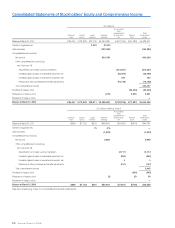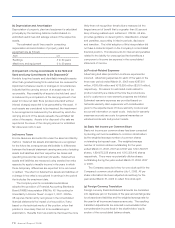Honda 2008 Annual Report Download - page 72
Download and view the complete annual report
Please find page 72 of the 2008 Honda annual report below. You can navigate through the pages in the report by either clicking on the pages listed below, or by using the keyword search tool below to find specific information within the annual report.
A n n u a l R e p o r t 2 0 0 8
7 0
(k) Depreciation and Amortization
Depreciation of property, plant and equipment is calculated
principally by the declining-balance method based on
estimated useful lives and salvage values of the respective
assets.
The estimated useful lives used in computing
depreciation and amortization of property, plant and
equipment are as follows:
Asset Life
Buildings 3 to 50 years
Machinery and equipment 2 to 20 years
(l) Impairment of Long-Lived Assets to Be Held and
Used and Long-Lived Assets to Be Disposed Of
Honda’s long-lived assets and identifiable intangible assets
other than goodwill having finite useful lives are reviewed for
impairment whenever events or changes in circumstances
indicate that the carrying amount of an asset may not be
recoverable. Recoverability of assets to be held and used
is measured by a comparison of the carrying amount of an
asset to future net cash flows (undiscounted and without
interest charges) expected to be generated by the asset. If
such assets are considered to be impaired, the impairment
to be recognized is measured by the amount by which the
carrying amount of the assets exceeds the estimated fair
value of the assets. Assets to be disposed of by sale are
reported at the lower of the carrying amount or estimated
fair value less costs to sell.
(m) Income Taxes
Income taxes are accounted for under the asset and liability
method. Deferred tax assets and liabilities are recognized
for the future tax consequences attributable to differences
between the financial statement carrying amounts of existing
assets and liabilities and their respective tax bases and
operating loss and tax credit carryforwards. Deferred tax
assets and liabilities are measured using enacted tax rates
expected to apply to taxable income in the years in which
those temporary differences are expected to be recovered
or settled. The effect on deferred tax assets and liabilities of
a change in tax rates is recognized in earnings in the period
that includes the enactment date.
The Company and its consolidated subsidiaries
adopted the provision of Financial Accounting Standards
Board (FASB) Interpretation (FIN) No. 48 “Accounting for
Uncertainty in Income Taxes” on April 1, 2007. FIN No.
48 requires that an entity recognizes in the consolidated
financial statements the impact of a tax position, if any,
based on the technical merits of the position, when that
position is more likely than not to be sustained upon
examination. Benefits from tax positions that meet the more
likely than not recognition threshold are measured at the
largest amount of benefit that is a greater than 50 percent
likely of being realized upon settlement. FIN No. 48 also
provides guidance on derecognition, classification, interest
and penalties, accounting in interim periods, disclosure
and transition. The initial adoption of this interpretation did
not have a material impact on the Company’s consolidated
financial position. Honda accounts for interest and penalties
related to the liability for unrecognized tax benefits as a
component of income tax expense in the consolidated
statement of income.
(n) Product-Related Expenses
Advertising and sales promotion costs are expensed as
incurred. Advertising expenses for each of the years in the
three-year period ended March 31, 2008 were ¥287,901
million, ¥308,409 million and ¥315,656 million ($3,151 million),
respectively. Provisions for estimated costs related to
product warranty are made at the time the products are
sold to customers or new warranty programs are initiated.
Estimated warranty expenses are provided based on
historical warranty claim experience with consideration
given to the expected level of future warranty costs as well
as current information on repair costs. Included in warranty
expenses accruals are costs for general warranties on
vehicles Honda sells and product recalls.
(o) Basic Net Income per Common Share
Basic net income per common share has been computed
by dividing net income available to common stockholders
by the weighted average number of common shares
outstanding during each year. The weighted average
number of common shares outstanding for the years
ended March 31, 2006, 2007 and 2008 was 1,840,799,671
shares, 1,824,675,228 shares and 1,815,356,440 shares
respectively. There were no potentially dilutive shares
outstanding during the years ended March 31, 2006, 2007
or 2008.
The Company executed a two-for-one stock split for the
Company’s common stock effective July 1, 2006. All per
share information has been adjusted retroactively for the
year ended March 31, 2006 to reflect this stock split.
(p) Foreign Currency Translation
Foreign currency financial statement amounts are translated
into Japanese yen on the basis of the year-end exchange rate
for all assets and liabilities and the weighted average rate for
the year for all income and expense amounts. The resulting
translation adjustments are included in accumulated other
comprehensive income (loss) in the stockholders’ equity
section of the consolidated balance sheets.
























